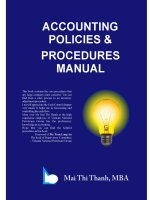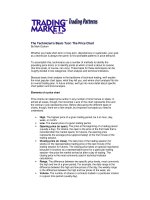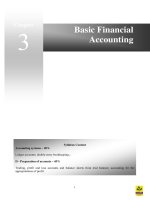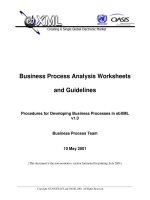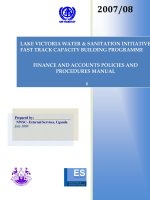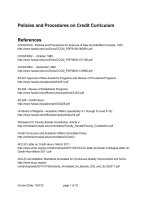CH17 basic numerical procedures
Bạn đang xem bản rút gọn của tài liệu. Xem và tải ngay bản đầy đủ của tài liệu tại đây (695.08 KB, 39 trang )
Basic Numerical Procedures
Chapter 18
Tree Approaches to Derivatives Valuation
Trees
Monte Carlo simulation
Finite difference methods
Binomial Trees
Binomial trees are frequently used to approximate the movements in the
price of a stock or other asset
In each small interval of time the stock price is assumed to move up by a
proportional amount u or to move down by a proportional amount d
Movements in Time ∆t
(Figure 17.1, page 392)
Su
Sd
S
1. Tree Parameters for asset paying a dividend yield of q
Parameters p, u, and d are chosen so that the tree gives correct values for the mean &
variance of the stock price changes in a risk-neutral world
Mean: e
(r-q)∆t
= pu + (1– p )d
Variance: σ
2
∆t = pu
2
+ (1– p )d
2
– e
2(r-q)∆t
A further condition often imposed is u = 1/ d
2. Tree Parameters for asset paying a dividend yield of q
(Equations 17.4 to 17.7)
When ∆t is small a solution to the equations is
tqr
t
t
ea
du
da
p
ed
eu
∆−
∆σ−
∆σ
=
−
−
=
=
=
)(
The Complete Tree
(Figure 17.2, page 394)
S
0
u
2
S
0
u
4
S
0
d
2
S
0
d
4
S
0
S
0
u
S
0
d
S
0
S
0
S
0
u
2
S
0
d
2
S
0
u
3
S
0
u
S
0
d
S
0
d
3
Backwards Induction
We know the value of the option at the final nodes
We work back through the tree using risk-neutral valuation to
calculate the value of the option at each node, testing for
early exercise when appropriate
Example: Put Option
(Example 17.1, page 394)
S
0
= 50; K = 50; r =10%; σ = 40%;
T = 5 months = 0.4167;
∆t = 1 month = 0.0833
The parameters imply
u = 1.1224; d = 0.8909;
a = 1.0084; p = 0.5073
Example (continued)
Figure 17.3, page 395
89.07
0.00
79.35
0.00
70.70 70.70
0.00 0.00
62.99 62.99
0.64 0.00
56.12 56.12 56.12
2.16 1.30 0.00
50.00 50.00 50.00
4.49 3.77 2.66
44.55 44.55 44.55
6.96 6.38 5.45
39.69 39.69
10.36 10.31
35.36 35.36
14.64 14.64
31.50
18.50
28.07
21.93
Calculation of Delta
Delta is calculated from the nodes at time ∆t
Delta =
−
−
= −
2 16 6 96
5612 44 55
0 41
. .
. .
.
Calculation of Gamma
Gamma is calculated from the nodes at time 2∆t
∆ ∆
∆ ∆
1 2
2
0 64 3 77
62 99 50
0 24
3 77 10 36
50 39 69
0 64
1165
0 03
=
−
−
= − =
−
−
= −
−
=
. .
.
. ;
. .
.
.
.
.Gamma =
1
Calculation of Theta
Theta is calculated from the central nodes at times 0 and 2∆t
Theta = per year
or - . per calendar day
3 77 4 49
01667
4 3
0 012
. .
.
.
−
= −
Calculation of Vega
We can proceed as follows
Construct a new tree with a volatility of 41% instead of 40%.
Value of option is 4.62
Vega is
4 62 4 49 013. . .− =
per 1% change in volatility
Trees for Options on Indices, Currencies and Futures
Contracts
As with Black-Scholes:
For options on stock indices, q equals the dividend yield on the index
For options on a foreign currency, q equals the foreign risk-free rate
For options on futures contracts q = r
Binomial Tree for Dividend Paying Stock
Procedure:
Draw the tree for the stock price less the present value of the dividends
Create a new tree by adding the present value of the dividends at each node
This ensures that the tree recombines and makes assumptions similar to those
when the Black-Scholes model is used
Extensions of Tree Approach
Time dependent interest rates
The control variate technique
Alternative Binomial Tree
(Section 17.4, page 406)
Instead of setting u = 1/d we can set each of the 2 probabilities to 0.5
and
ttqr
ttqr
ed
eu
∆σ−∆σ−−
∆σ+∆σ−−
=
=
)2/(
)2/(
2
2
Trinomial Tree (Page 409)
S S
Sd
Su
p
u
p
m
p
d
6
1
212
3
2
6
1
212
/1
2
2
2
2
3
+
σ
−
σ
∆
−=
=
+
σ
−
σ
∆
=
==
∆σ
r
t
p
p
r
t
p
udeu
d
m
u
t
Time Dependent Parameters in a Binomial Tree (page 409)
Making r or q a function of time does not affect the geometry of the tree.
The probabilities on the tree become functions of time.
We can make σ a function of time by making the lengths of the time steps
inversely proportional to the variance rate.
Monte Carlo Simulation and π
How could you calculate π by randomly sampling points in the square?
Monte Carlo Simulation and Options
When used to value European stock options, Monte Carlo simulation involves the following steps:
1. Simulate 1 path for the stock price in a risk neutral world
2. Calculate the payoff from the stock option
3. Repeat steps 1 and 2 many times to get many sample payoff
4. Calculate mean payoff
5. Discount mean payoff at risk free rate to get an estimate of the value of the option
Sampling Stock Price Movements
(Equations 17.13 and 17.14, page 411)
In a risk neutral world the process for a stock price is
We can simulate a path by choosing time steps of length ∆t and using the
discrete version of this
where ε is a random sample from φ(0,1)
tStSS ∆εσ+∆µ=∆
ˆ
dS S dt S dz= +
µ σ
A More Accurate Approach
(Equation 17.15, page 412)
( )
( )
( )
tt
etSttS
tttSttS
dzdtSd
∆εσ+∆σ−µ
=∆+
∆σε+∆σ−µ=−∆+
σ+σ−µ=
or
is this of version discrete The
Use
2/
ˆ
2
2
2
)()(
2/
ˆ
)(ln)(ln
2/
ˆ
ln
Extensions
When a derivative depends on several underlying variables we can
simulate paths for each of them in a risk-neutral world to calculate
the values for the derivative

